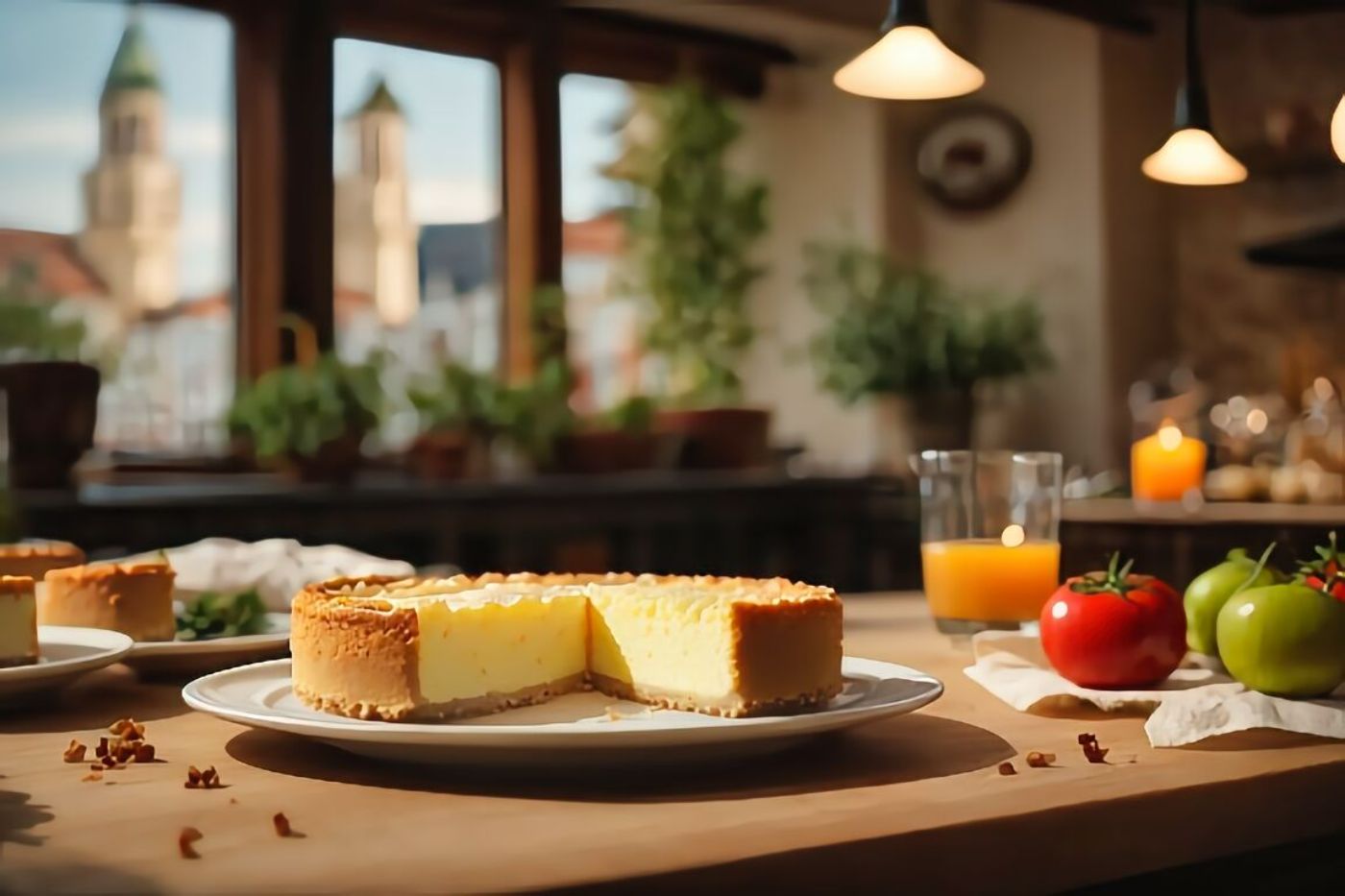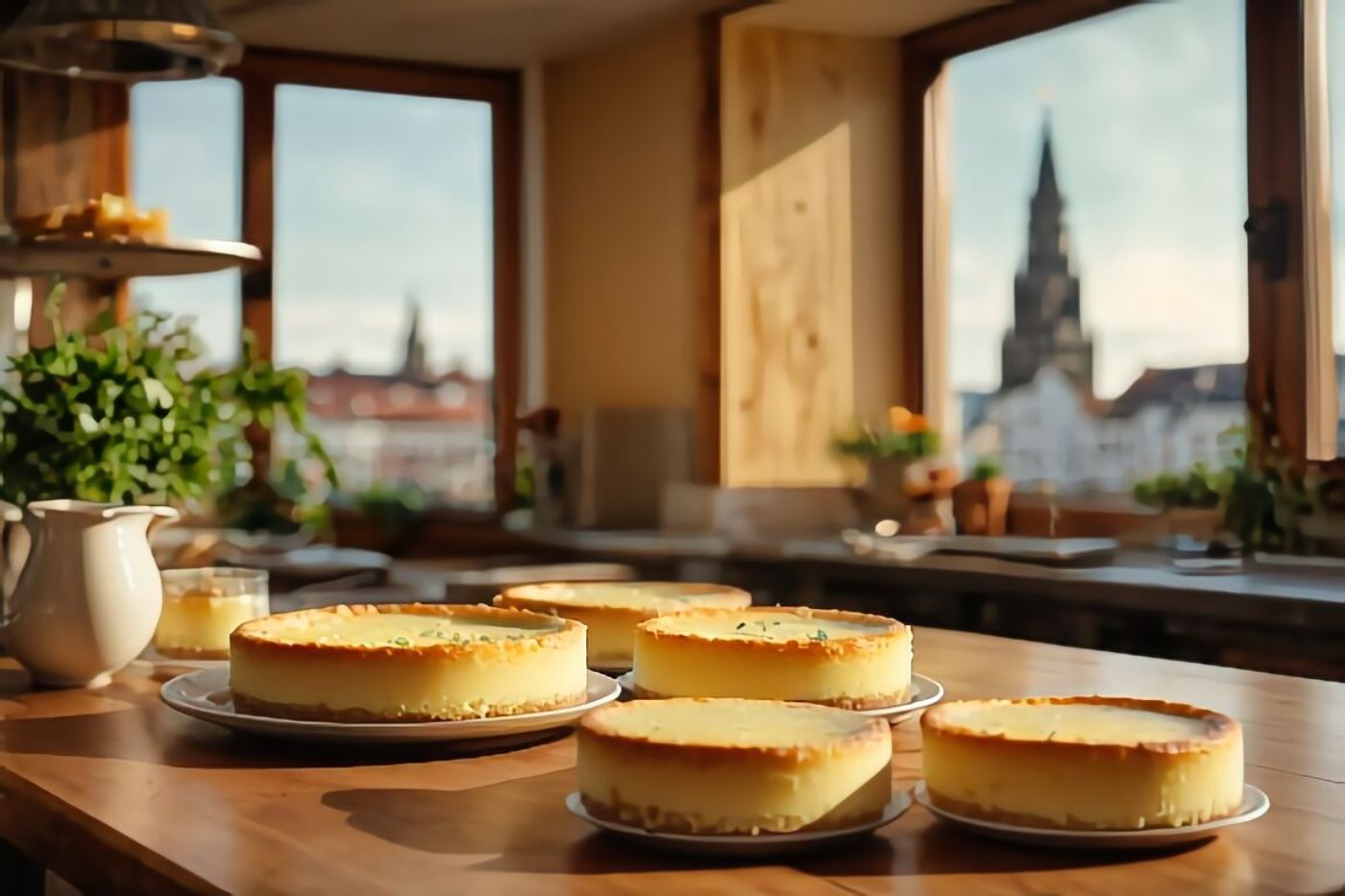
The Käsekuchens (German Cheesecake) Recipe is a traditional German dessert that has been cherished for generations. It is characterized by its creamy and rich texture, making it a delightful treat for those with a sweet tooth. This dessert consists of a luscious cheese filling enclosed in a buttery crust. The flavor profile is a lovely blend of mild sweetness and a subtle tanginess, creating a satisfying taste experience.
German Food History:
Germany boasts a rich culinary heritage that has evolved over centuries. Its food history is marked by the influence of neighboring European countries and regions. Traditional German cuisine is known for its hearty and wholesome dishes, such as sausages, schnitzels, and stews. The use of ingredients like potatoes, bread, and dairy has been prevalent throughout history. Additionally, the art of baking, which includes pastries and cakes like the Käsekuchens, has been a prominent aspect of German food culture.
Want more ideas for Your German Recipe Box?
A lot of great options are in these posts!
24 Traditional German Recipes/a>
You May Want to Join The World Recipes With Our Big Escape
Share your own recipes in our Facebook Group. Find recipes from all over the world. Learn more about International Cuisine and how you can surprise your family with new and exciting foods from all over the world.
For More Photos Visit Our Instagram at World Recipes Daily
Modern Food vs Historic Food:
Historically, German cuisine was rooted in simplicity and practicality, with a focus on using locally available ingredients. Traditional dishes were often prepared using straightforward methods, reflecting the agricultural and economic conditions of the time. In contrast, modern German cuisine has seen an evolution towards more diverse and international flavors. The influence of globalization has introduced a wider range of ingredients and cooking techniques, resulting in a more cosmopolitan culinary landscape. However, traditional dishes like the Käsekuchens continue to hold a special place in the hearts of Germans, serving as a link to their culinary heritage.
Käsekuchens (German Cheesecake) Recipe Health Benefits:
While the Käsekuchens (German Cheesecake) Recipe is undeniably indulgent, it does offer some nutritional benefits. The cheese used in the recipe provides a good source of protein and calcium. Protein is essential for the body’s growth and repair, while calcium is crucial for maintaining strong bones and teeth. Additionally, the moderate sweetness of the dessert ensures that it can be enjoyed in moderation without causing excessive spikes in blood sugar levels. However, it’s important to consume this delightful treat in reasonable portions to maintain a balanced diet.
In summary, the Käsekuchens (German Cheesecake) Recipe is a beloved German dessert known for its creamy, indulgent nature. Germany’s food history is a testament to its culinary traditions, rooted in simplicity and practicality. While modern German cuisine has evolved to embrace a wider range of flavors, traditional dishes like the Käsekuchens remain cherished. From a health perspective, this dessert can provide essential nutrients like protein and calcium when enjoyed in moderation.

How To Make Our Käsekuchens (German Cheesecake) Recipe
Ingredients (8 Servings)
Crust
1 1/2 Cups flour
1 tsp baking powder
pinch of salt
2 tsp vanilla sugar (or 1 tsp of vanilla extract)
1 tbsp finely grated lemon rind
1/4 cup granulated sugar
6 tbsp butter
1 egg (beaten)
Filling
3 egg yolks
3/4 Cup granulated sugar
2 tsp vanilla sugar (or 1 tsp extract)
6 tbsp butter (room temp)
3/4 cup [170ml] heavy cream
2 Cups plain Quark (or Greek yogurt)
1 1/2 tsp cornstarch
3 egg whites
pinch of salt
Instructions
1. Preheat the Oven.
a. Preheat your oven to 350°F (175°C).
2. Prepare the Crust.
a. In a mixing bowl, combine 1 1/2 cups (180g) of flour, 1 tsp of baking powder, and a pinch of salt.
b. Add 2 tsp of vanilla sugar (or 1 tsp of vanilla extract), 1 tbsp of finely grated lemon rind, and 1/4 cup (50g) of granulated sugar to the dry ingredients.
c. Cut in 6 tbsp (85g) of room temperature butter until the mixture resembles coarse crumbs.
d. Stir in 1 beaten egg to form a dough.
e. Press the dough evenly into the bottom of a greased 9-inch (23cm) springform pan, creating a crust.
3. Prepare the Filling.
a. In a separate mixing bowl, whisk together 3 egg yolks and 3/4 cup (150g) of granulated sugar until well combined.
b. Add 2 tsp of vanilla sugar (or 1 tsp of extract) and 6 tbsp (85g) of room temperature butter to the egg mixture and mix until smooth.
c. Stir in 3/4 cup (170ml) of heavy cream and 2 cups (450g) of plain Quark (or Greek yogurt) until fully incorporated.
d. In a small bowl, dissolve 1 1/2 tsp of cornstarch in a little water to create a slurry, then add it to the filling mixture and blend well.
e. In a separate bowl, beat 3 egg whites with a pinch of salt until stiff peaks form. Gently fold the beaten egg whites into the filling mixture until fully combined.
4. Assemble and Bake.
a. Pour the filling over the prepared crust in the springform pan, spreading it evenly.
b. Place the pan in the preheated oven and bake for approximately 45-50 minutes or until the cheesecake is set and the top is lightly browned.
c. Remove the Käsekuchens from the oven and let it cool in the pan on a wire rack.
d. Once cooled, refrigerate the cheesecake for several hours or overnight to allow it to firm up.
5. Serve.
a. Carefully remove the cheesecake from the springform pan.
b. Slice the Käsekuchens into portions and serve chilled.
Estimated Prep Time: 30 minutes
Estimated Cooking Time: 45-50 minutes

Pots, Pans and Cooking Equipment Needed for The Käsekuchens (German Cheesecake) Recipe
1. Mixing bowls
2. 9-inch (23cm) springform pan
3. Whisk
4. Baking sheet (for placing under the springform pan in case of leaks)
5. Measuring cups and spoons
6. Wire rack
7. Oven
Best Way to Store Leftovers From The Käsekuchens (German Cheesecake) Recipe
a. Store leftover Käsekuchens in an airtight container to maintain freshness.
b. Refrigerate the cheesecake to keep it chilled and safe to eat.
c. For longer storage, you can freeze individual slices wrapped in plastic wrap and aluminum foil.
d. Label the container with the date to keep track of freshness.
e. Consume leftovers within 3-4 days for the best taste and texture.
f. When reheating, use a microwave or oven to gently warm the slices.
Tips and Tricks For Easier Creation
To avoid a cracked cheesecake, bring all ingredients to room temperature before mixing.
Use a water bath (bain-marie) during baking to ensure even cooking and prevent cracking.
Grease the springform pan thoroughly to prevent sticking.
Allow the cheesecake to cool completely before removing it from the pan.
Dust the top with powdered sugar or serve with fruit compote for added flavor.
Experiment with different toppings like fresh berries or chocolate shavings.
For a lighter version, substitute Greek yogurt for Quark in the filling.
Side Dishes and Desserts For the The Käsekuchens (German Cheesecake) Recipe
a. Fresh fruit salad
b. Whipped cream
c. Raspberry coulis
d. Vanilla ice cream
e. Sliced strawberries
f. Mint garnish
g. Fruit compote
How To Serve the Käsekuchens (German Cheesecake) Recipe
a. Carefully remove the cheesecake from the springform pan.
b. Slice the Käsekuchens into portions using a sharp knife.
c. Use a cake server or spatula to lift each slice onto a plate.
d. Garnish with your choice of toppings, such as fresh berries or a dollop of whipped cream.
e. Serve chilled for the best flavor and texture.
f. Enjoy your delicious Käsekuchens (German Cheesecake) with your chosen side dish.

FAQ About The Käsekuchens (German Cheesecake) Recipe
What is the origin of the Käsekuchens (German Cheesecake) Recipe?
The Käsekuchens (German Cheesecake) Recipe has its origins in Germany, where it has been a beloved dessert for generations.
How does Käsekuchens (German Cheesecake) differ from traditional cheesecake?
Käsekuchens (German Cheesecake) typically has a lighter and creamier texture compared to traditional cheesecake, with the use of Quark or Greek yogurt in the filling.
Can I substitute Quark with Greek yogurt in the Käsekuchens (German Cheesecake) Recipe?
Yes, you can substitute Quark with Greek yogurt in the Käsekuchens (German Cheesecake) Recipe for a similar creamy texture.
Is Käsekuchens (German Cheesecake) typically served with any specific toppings?
Käsekuchens (German Cheesecake) is often served with toppings like fresh berries, fruit compote, or a dusting of powdered sugar.
What is the recommended way to store leftover Käsekuchens (German Cheesecake)?
Leftover Käsekuchens (German Cheesecake) should be stored in an airtight container in the refrigerator to maintain its freshness and taste.
Final Thoughts
“We are a couple who has visited and sampled food in every country in the world. We strive to get a local recipe for every dish we place on our blog. Some we have cooked in our kitchen but most we enjoyed in the restaurants and streets of the world. Our thoughts and opinions are based on the food we loved the most and you may find them and others you will fall in love with as well. Please enjoy the recipe and comment below.”
The Käsekuchens (German Cheesecake) Recipe is a delightful dessert that hails from Germany, renowned for its creamy and rich texture. This beloved German cheesecake is distinct from the more familiar American cheesecake. It is cherished for its simplicity and unique combination of ingredients.
The key to the Käsekuchens (German Cheesecake) Recipe lies in its filling, which features Quark or Greek yogurt as the primary cheese component. Quark is a fresh and creamy dairy product that adds a mild tanginess and smooth consistency to the cheesecake. This sets it apart from the denser and richer American cheesecakes that typically use cream cheese.
The crust of the Käsekuchens (German Cheesecake) Recipe provides a perfect contrast to the creamy filling. It’s made from a combination of flour, butter, sugar, and a hint of lemon zest for a subtle citrusy aroma. This crust is not overly sweet and provides a delightful balance to the cheesecake’s creaminess.
One of the distinguishing features of this German cheesecake is its lightness. It’s not as heavy or sweet as its American counterpart, making it a perfect dessert for those who prefer a milder, less indulgent sweetness. The use of heavy cream in the filling contributes to its creamy texture, while the egg whites beaten to stiff peaks add a fluffy and airy quality.
The Käsekuchens (German Cheesecake) Recipe is often enjoyed with a variety of toppings. Fresh berries, such as raspberries or strawberries, are a popular choice. The tartness of the berries complements the cheesecake’s sweetness beautifully. Additionally, some variations include a dusting of powdered sugar or a drizzle of fruit compote for added flavor.
In Germany, Käsekuchens is a beloved dessert enjoyed on various occasions, from family gatherings to special celebrations. It’s a versatile dessert that can be served as a delightful ending to a meal or enjoyed with a cup of coffee during afternoon tea.
Whether you choose to make it yourself or savor it in a German cafe, the Käsekuchens (German Cheesecake) Recipe offers a taste of traditional German cuisine. Its unique combination of ingredients and lighter texture make it a delightful dessert option for those looking to explore the world of cheesecakes beyond the familiar New York-style. Enjoy the creamy, tangy, and mildly sweet flavors of this beloved German treat, and perhaps, it will become one of your favorite desserts as well.
Käsekuchens (German Cheesecake) Recipe
Equipment
- Mixing bowls
- 9-inch (23cm) springform pan
- whisk
- Baking sheet (for placing under the springform pan in case of leaks)
- Measuring cups and spoons
- Wire rack
- Oven
Ingredients
Crust
- 1 1/2 Cups flour
- 1 tsp baking powder
- pinch salt
- 2 tsp sugar with vanilla or 1 tsp of vanilla extract
- 1 tbsp lemon rind finely grated
- 1/4 cup sugar granulated
- 6 tbsp butter
- 1 egg beaten
Filling
- 3 egg yolks
- 3/4 Cup sugar granulated
- 2 tsp vanilla extract
- 6 tbsp butter room temp
- 3/4 cup heavy cream
- 2 Cups plain Quark or Greek yogurt
- 1 1/2 tsp cornstarch
- 3 egg whites
- pinch of salt
Instructions
Preheat the Oven.
- a. Preheat your oven to 350°F (175°C).
Prepare the Crust.
- a. In a mixing bowl, combine 1 1/2 cups (180g) of flour, 1 tsp of baking powder, and a pinch of salt.
- b. Add 2 tsp of vanilla sugar (or 1 tsp of vanilla extract), 1 tbsp of finely grated lemon rind, and 1/4 cup (50g) of granulated sugar to the dry ingredients.
- c. Cut in 6 tbsp (85g) of room temperature butter until the mixture resembles coarse crumbs.
- d. Stir in 1 beaten egg to form a dough.
- e. Press the dough evenly into the bottom of a greased 9-inch (23cm) springform pan, creating a crust.
Prepare the Filling.
- a. In a separate mixing bowl, whisk together 3 egg yolks and 3/4 cup (150g) of granulated sugar until well combined.
- b. Add 2 tsp of vanilla sugar (or 1 tsp of extract) and 6 tbsp (85g) of room temperature butter to the egg mixture and mix until smooth.
- c. Stir in 3/4 cup (170ml) of heavy cream and 2 cups (450g) of plain Quark (or Greek yogurt) until fully incorporated.
- d. In a small bowl, dissolve 1 1/2 tsp of cornstarch in a little water to create a slurry, then add it to the filling mixture and blend well.
- e. In a separate bowl, beat 3 egg whites with a pinch of salt until stiff peaks form. Gently fold the beaten egg whites into the filling mixture until fully combined.
Assemble and Bake.
- a. Pour the filling over the prepared crust in the springform pan, spreading it evenly.
- b. Place the pan in the preheated oven and bake for approximately 45-50 minutes or until the cheesecake is set and the top is lightly browned.
- c. Remove the Käsekuchens from the oven and let it cool in the pan on a wire rack.
- d. Once cooled, refrigerate the cheesecake for several hours or overnight to allow it to firm up.
Serve.
- a. Carefully remove the cheesecake from the springform pan.
- b. Slice the Käsekuchens into portions and serve chilled.

